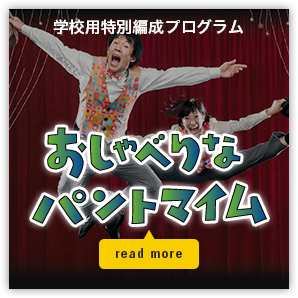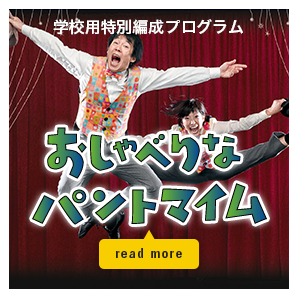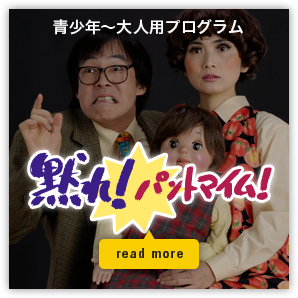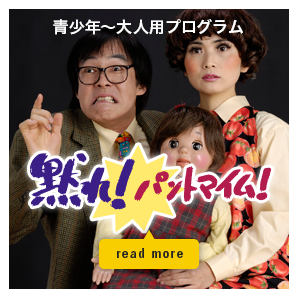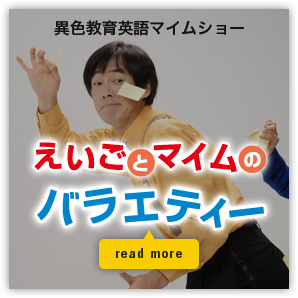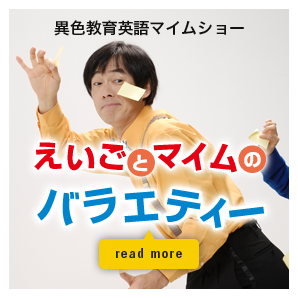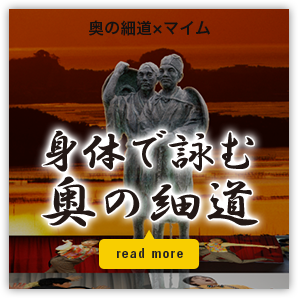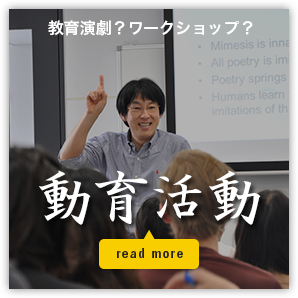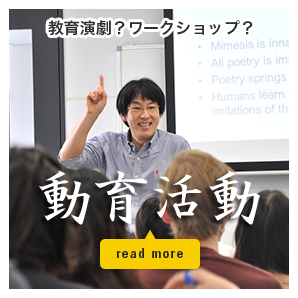我が母校である、米国ウィスコンシン大学の教育学部のニュースに私のインタビューが掲載されました。これは昨年、来日した同大学の国際コミュニケーション委員会の代表の方々が早稲田大学を訪れ、私に一時間ほどインタビューをした内容です。
School of Education News
A mime speaks: Q&A with acclaimed performer and UW-Madison alum Takeo Fujikura
Mime has had a profound yet silent influence in mainstream culture for decades.
Charlie Chaplin, Blue Man Group, Dick Van Dyke, Rowan Atkinson and even Michael Jackson are just a few who have augmented their own entertainment styles through “the art of silence.”
UW–Madison alumnus Takeo Fujikura, founder of Kanjiyama Mime, a leading professional mime company in Japan, has developed his own performance style by discarding what some might deem essential to miming — the silence.
Since Kanjiyama was founded in 1986, the company has been regularly called upon not only to entertain, but also educate and provide commentary on social and political issues, as well as pop culture. Kanjiyama gives more than 120 performances annually throughout Japan and has made more than 50 national television network appearances.

Takeo Fujikura received a Ph.D. in educational drama from
UW-Madison in 2006. Today, the Department of Theatre
and Drama is housed within the School of Education.
Fujikura, who received his Ph.D. in educational drama from UW–Madison in 2006, is also a respected educator. Fujikura has taught at Waseda University and Sophia University, among other prestigious educational institutions in Japan.
UW–Madison’s International Division sat down with Fujikura to ask about mime, teaching and his time in Wisconsin.
UW–Madison: Your performance style is different than what audiences might expect from a mime. What made seek your own interpretation of mime?
TF: I had the pleasure of seeing Marcel Marceau, one of the great mime performers, when he was in Japan. Everyone who saw Marcel Marceau for the first time tried to imitate him — they wanted to be him, with the white-striped shirt, painted white face and silent. That’s how I started, too. I went to SUNY Binghamton for my BA and MA. During my days there, I studied there under a professional mine, Tony Montanero, who was a direct student of Marceau. He is the one who taught me to be myself. I grew up in a different culture with different experiences, so I couldn’t be Marceau. Tony was the first one to give me that inspiration. From there I started searching for my own style.
UW–Madison: What makes your style of performing unique?
TF: Many audiences don’t appreciate what performers try to say with the mime. Rather they turn a performance into a sort of guessing game, where they are trying to figure out what I am saying, I give them information that sets the stage for what they are about to see. For example, I might tell them that in my childhood we would go to festivals and my parents would buy me masks. Then I show them the mask technique and how it is used in mime. Then, by the time that technique is used in the sketch, they understand what is being used and can focus on the message of the sketch. I also use a lot of onomatopoeia. Inserting that into performances can have a profound effect.

Takeo Fujikura is currently a faculty member at
Sophia University and Waseda University in Tokyo.
UW–Madison: How do your audiences typically react to your performances?
TF: I usually begin with comedy and then move to more dramatic subjects, so you can visibly see the changes in attitude during the performance. Many cry. It is very emotional for them.
There is a sketch I created, which deals with death called, “The Violinist.” The violinist has a son in bed. He sees to his son in bed, giving him his medicine, and then he goes to work where he is a violinist on the street. While playing violin he remembers playing with his son. He collects the money patrons have left, which isn’t much. On his way home he stops by a toy shop and finds a smiling mask. He buys the mask and rushes back home with the mask to surprise his son. He tries to wake the son repeatedly only to find he will no longer wake. Eventually the violinist gives up on waking his son, but the smiling mask stays in place. Audience sees the agony of the violinist behind the mask, which is far more dramatic than seeing a crying face.
UW–Madison: What are some of the major considerations when you’re developing a sketch?
TF: Considering the audience is key. Along with that is making sure you are adapting the materials for each generation. Before Marcel Marceau died, he said it was a tough era for mimes because less and less movement is involved in everyday life.
Think about counting money (gestures moving bills from his hand across the table). There is less motion in the current generation in that payment can be done with a click or inserting a card. As people become less animated in real life, I am limited in the things I can portray during performances.
UW–Madison: Alongside performing, you’re also a faculty member. What kind of courses are you teaching?
TF: I am currently on faculty at Sophia University and Waseda University in Tokyo. At one point I was teaching at four universities, but with performing that got to be a bit much.
Some of my current courses include History of Theatre, History of Nonverbal Theatre, and Marginalized Theatre. I have also frequently taught the History and Practice of the Art of Mime and Pantomime, Introduction to Acting and Expression, and Educational Drama.
UW–Madison: You focused on educational drama at UW–Madison. Do those lessons often come into play in your classroom?
TF: I do use a lot of these principles for my students. For example, if I were using traditional educational methods to make students understand how blind individuals would feel navigating the world, I might try to explain it using words. A dramatic technique would be to blindfold them and put them out on a busy street, supervised, of course. It would be a much more profound experience. It allows students to really experience a situation in other ways. That is the strength of active learning.
UW–Madison: Was it always the plan to shift toward teaching after you finished your Ph.D. program?
TF: I was actually planning to return to Japan and perform. I was lucky in that I was offered a position where I could create my own classes. The timing was also great as NHK, Japan’s national broadcasting organization, was really interested in the educational aspect of miming. They offered to let me take a slot on a children’s program, so everything worked out nicely. I still work with NHK, today, doing the choreography for the physical expression corner, “Panto!” on the organization’s most popular children’s program, “Okasan to Issho”(Together with My Mom).
UW–Madison: What else comes to mind when thinking about UW–Madison?
TF: I actually met my wife, Yumi, while studying at UW. She was studying Japanese linguistics, which UW–Madison is well known for. I had joined the Madison Japan Association and became chair. She was my secretary, and so we got to know each other.
UW–Madison is a special place for me. I return to Wisconsin almost every year. My son is going through entrance exams for junior high. Maybe in another few years he will be a Badger as well!
UW-Madison’s Department of Theatre and Drama is housed within the School of Education

